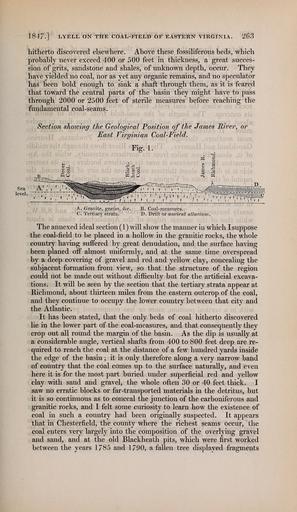MAKE A MEME
View Large Image

| View Original: | The_Quarterly_journal_of_the_Geological_Society_of_London_(13205983323).jpg (1199x2069) | |||
| Download: | Original | Medium | Small | Thumb |
| Courtesy of: | commons.wikimedia.org | More Like This | ||
| Keywords: The Quarterly journal of the Geological Society of London (13205983323).jpg 184/ LYELL ON THE COAL-FIELD OF EASTERN VIRGINIA 2 53 <br> hitherto discovered elsewhere Above these fossiliferous beds which <br> probably never exceed 400 or 500 feet in thickness a great succes- <br> sion of grits sandstone and shales of unknown depth occur They <br> have yielded no coal nor as yet any organic remains and no speculator <br> has been bold enough to sink a shaft through them as it is feared <br> that toward the central parts of the basin they might have to pass <br> through 2000 or 2500 feet of sterile measures before reaching the <br> fundamental coal-seams <br> Section showing the Geological Position of the James Rive or <br> East Virginian Coal-Field <br> Fig 1 <br> A Granite gneiss Sec B Coal-measures <br> C Tertiary strata D Drift or m cient ullmnum <br> The annexed ideal section 1 will show the manner in which I suppose <br> the coal-field to be placed in a hollow in the granitic rocks the whole <br> country having suifered by great denudation and the surface having <br> been planed off almost uniformly and at the same time overspread <br> by a deep covering of gravel and red and yellow clay concealing the <br> subjacent formation from view so that the structure of the region <br> could not be made out without difficulty but for the artificial excava- <br> tions It will be seen by the section that the tertiary strata appear at <br> Richmond about thirteen miles from the eastern outcrop of the coal <br> and they continue to occupy the lower country between that city and <br> the Atlantic <br> It has been stated that the only beds of coal hitherto discovered <br> lie in the lower part of the coal-measures and that consequently they <br> crop out all round the margin of the basin As the dip is usually at <br> a considerable angle vertical shafts from 400 to 800 feet deep are re- <br> quired to reach the coal at the distance of a few hundred yards inside <br> the edge of the basin ; it is only therefore along a very narrow band <br> of country that the coal comes up to the surface naturally and even <br> here it is for the most part buried under superficial red and yellow <br> clay with sand and gravel the whole often 30 or 40 feet thick I <br> saw no erratic blocks or far-transported materials in the detritus but <br> it is so continuous as to conceal the junction of the carboniferous and <br> granitic rocks and I felt some curiosity to learn how the existence of <br> coal in such a country had been originally suspected It appears <br> that in Chesterfield the county where the richest seams occur the <br> coal enters very largely into the composition of the overlying gravel <br> and sand and at the old Blackheath pits which were first worked <br> between the years 1785 and 1790 a fallen tree displayed fragments 36933002 113687 51125 Page 263 Text v 3 http //www biodiversitylibrary org/page/36933002 1847 Geological Society of London Biodiversity Heritage Library The Quarterly journal of the Geological Society of London v 3 1847 Geology Periodicals Smithsonian Libraries bhl page 36933002 dc identifier http //biodiversitylibrary org/page/36933002 smithsonian libraries Information field Flickr posted date ISOdate 2014-03-17 Check categories 2015 August 26 CC-BY-2 0 BioDivLibrary https //flickr com/photos/61021753 N02/13205983323 2015-08-26 12 56 32 cc-by-2 0 PD-old-70-1923 The Quarterly journal of the Geological Society of London 1847 Photos uploaded from Flickr by Fæ using a script | ||||